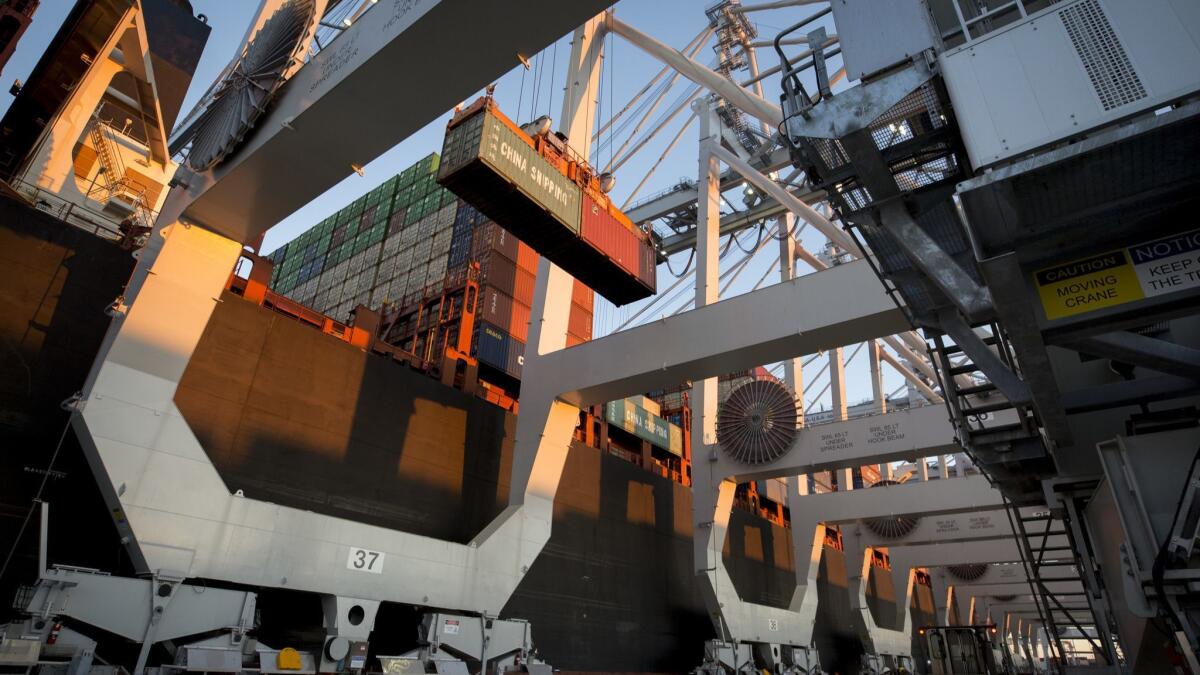Editorial: There’s no quick fix to our trade standoff with China

After months of matching the Trump administration’s trade-war maneuvering in tit-for-tat fashion, the Chinese government has started making what appear to be peace offerings.
On Dec. 1 the two sides announced a tariff cease-fire, with the U.S. suspending a planned 150% increase in duties for 90 days while the two sides resume negotiations over Chinese policies that harm U.S. exporters and investors. While the tariff detente hasn’t stopped the Trump administration from trying to pressure Beijing in other ways — for example, by pursuing criminal charges against Chinese hackers — China has gone in the opposite direction, making its first purchase of U.S. soybeans in months and rolling back tariffs on imported U.S. cars from 40% to 15%.
In a potentially more significant move, the Chinese government has also de-emphasized President Xi Jinping’s ambitious “Made in China 2025” plan to turn Chinese industries into leading producers of robotics, electric vehicles and other advanced technologies — presumably with the help of generous government subsidies. Analysts differ on whether the government is rewriting the initiative, delaying it or just not pushing it as forcefully as before. But by leaving the plan out of its latest marching orders to local officials, China’s central government is at least recognizing how much an irritant Made in China 2025 had become to the Trump administration.
To force a change in China’s behavior, the U.S. needs to present a unified front with the other major countries in Europe and the Americas.
Still, Trump has no grounds for declaring victory yet. Chinese officials have offered concessions throughout this trade dispute, and the ones put on the table in recent days are well short of the structural reforms the United States is demanding. Beyond that, even when China agrees to a significant reform, it does not necessarily deliver it — witness the agreement Xi struck with President Obama in 2015 to curtail Chinese hackers’ theft of trade secrets, a practice that continues to this day, albeit at a less feverish pace. Nor did the agreement stop China from stealing military secrets and personal data through the internet.
That’s not to say the president’s bad-cop approach to trade hasn’t made a difference to China. It certainly seems to have contributed to the slowdown in China’s economy that has roiled global stock markets and hurt Xi’s standing at home. Some analysts say the pressure has made China eager for a deal.
Yet the collateral damage from the tariffs Trump has imposed is significant and would grow considerably worse, both in the U.S. and elsewhere, if negotiations fell through and Trump slapped China with even more tariffs. Soybeans are a good example — inventories of unsold American beans have doubled, and the Chinese purchase reported this week is about one-eighth of what farmers had been hoping for. Or look at solar panels, where U.S. tariffs on imports have led major installations to fall by 30%, according to an industry group. The direct benefit to U.S. panel makers can’t offset the indirect harms to the rest of the country’s solar power industry. Similarly, Trump’s tariffs on steel imports are raising prices and reducing demand for other U.S. goods, according to a new report from a business advocacy group.
Part of the problem here is that the president has his eyes on the wrong prize. He seems obsessed with the United States’ trade deficit with China — a deficit that has only grown since the tariff battles began — and may be satisfied if China simply agrees to buy considerably more U.S. exports. But running a trade deficit isn’t inherently bad; the problem in China’s case is the barriers thrown in the way of foreign competitors and investors, the forced transfer of key technology and trade secrets, the subsidies for government-owned enterprises and the lack of protection for patents and other intellectual property, among other fundamental, structural issues.
Enter the Fray: First takes on the news of the minute from L.A. Times Opinion »
The United States needs allies to win this fight. The U.S. economy isn’t as all-important globally as it used to be, and China has a growing number of other outlets for its goods. To force a change in China’s behavior, the U.S. needs to present a unified front with the other major countries in Europe and the Americas — the same ones Trump has been bullying or threatening to bully with steel, aluminum and car tariffs. The Obama administration assembled a coalition of the willing to confront China in Asia through the Trans-Pacific Partnership trade deal, but Trump tore that up on his first day in office.
Meanwhile, the World Trade Organization has done a poor job of enforcing against the sort of unfair trade practices China engages in. Trump has rightly demanded improvements, but it’s not clear from the administration’s actions or its rhetoric whether the president wants the WTO to be reformed or to be packed up.
The stakes here are enormous. Most economists surveyed by the Wall Street Journal this month ranked the trade fight with China as the biggest threat to the U.S. economy. The next months of negotiations with China will be crucial to determining whether the moves China is making now signal a willingness to give foreign companies and investors a level playing field or are just a delaying tactic. The administration would be well served to cast about for partners in its push for real change.
Follow the Opinion section on Twitter @latimesopinionand Facebook
More to Read
A cure for the common opinion
Get thought-provoking perspectives with our weekly newsletter.
You may occasionally receive promotional content from the Los Angeles Times.





